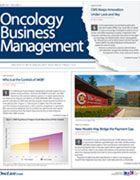Publication
Article
Special Issues
The New Administration May Speed Up the Pace of Innovation
Author(s):
With ambitious goals to improve outcomes and lower the cost of care, CMS has placed a lot of faith in its Oncology Care Model, an alternative payment model.
OncLive Chairman,
Mike Hennessy
With ambitious goals to improve outcomes and lower the cost of care, CMS has placed a lot of faith in its Oncology Care Model (OCM), an alternative payment model (APM). This model represents the prototype for coordinated, patient-centered care that CMS hopes will become the new standard. Many private groups are coming forward with their own designs for APMs that they would like CMS to certify for use. They maintain that having just the OCM does not provide them with ideal flexibility and that they can accomplish the dual goals of better outcomes and lower cost by innovating on their own.
Congress created the Physician Focused Payment Model Technical Advisory Committee specifically for the purpose of vetting APM designs and encouraging innovation. Physician groups, meanwhile, remain doubtful about the strength of CMS’ commitment to cooperate with that mandate. They say the agency may be too wedded to its own craftsmanship to allow competitive models. However, the outlook among physicians is changing with the incoming administration and the potential appointment of Rep Tom Price (R-GA) as the next secretary of Health and Human Services. Price opposes mandatory models of care and may pressure CMS to accelerate the review process on independent APMs. Read our story on page 14 to find out more.
New models of care that could be APMs are gaining traction—with a lot of elbow grease from practice staff. This month’s practice profile on the Center for Cancer and Blood Disorders in Fort Worth, Texas, explains how far this group has come in its transition to value-based care. The practice continues to negotiate terms with payers, but many other innovations are already in place, such as improved patient communication and greater reliance on standards of care rather than physician discretion. The story is on page 40.
Patient navigation is a hot concept these days due to the growing awareness that healthcare is so complicated that patients can’t find their way unaided. Many clinics are hiring patient navigators to assist with appointment scheduling, financial concerns, and more. One practice in Louisiana decided that patients’ family members and close friends can assume this role with support from the clinic. The Pontchartrain Cancer Center decided this would be the best means of stretching scarce resources without diminishing the quality of care. Kathy W. Oubre, MS, chief operating officer, explains on page 18 that patients receive a logbook at the outset of care that providers update with important information at each visit. This helps patients to understand their care process and to know exactly where they are going. It is an example of innovation that keeps patients at the center of care.
A year has passed and the Association of Community Cancer Centers took another poll of oncology providers to find out how their concerns have evolved. Lack of payment for some supportive care services placed high on the list again in 2016, with 66% of respondents checking the affirmative box. However, the cost of oncology drugs became a much greater concern than ever before: for 2015, 45% of respondents said this was a serious problem versus 83% in 2016. The most recent survey also included questions on new care delivery models, financial education for patients, and technology. Read about it on page 10.
There’s much more in this month’s Oncology Business ManagementTM. Enjoy!






%20u.jpg?fit=crop&auto=format)

